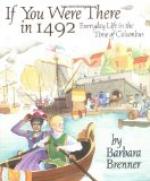The voyage was a miserable one. Contrary winds prevailed until provisions began to run short, and rations were doled out in pittances which grew scantier and scantier until all the admiral’s authority was needed to prevent his ravenous shipmates from killing and eating the Caribs who were on board,—in retribution, so ran the grim jest, for their cannibalism. At last, when famine was imminent, after a voyage of three months’ duration, the two caravels entered the Bay of Cadiz on the 11th of June, 1496.
Reception at court.
After about a month’s delay, Columbus received a summons to proceed to the Court, which was then at Burgos. In the course of his journey thither he adopted the same means of dazzling the eyes of the populace, by the display of gold and the exhibition of his captives, as on his return from his first voyage; but so many unsuccessful colonists had returned, sick at heart and ruined in health, to tell the tale of failure to their countrymen, that this triumphal procession was very unlike the last as regards the welcome accorded by the public. However the Sovereigns seem to have given the admiral a kind reception, and instead of placing him on his defence against the charges which had been brought forward by Father Buil, they listened with sympathy to his story of the difficulties which had beset him, and heard with sanguine satisfaction of the recent discovery of the mines from which it was said that the natives procured most of the gold that had been found in their possession, and which promised an incalculably rich harvest. Presently, in apparent confirmation of this belief, one Pedro Nino, a captain of the admiral’s, announced his arrival at Cadiz, with a quantity of “gold in bars” on board his ship. It was not until great expectations had been raised at Court, and the wildest ideas conceived of the magnitude of this supposed first instalment of the riches of the newly found gold mines, that it turned out that this Nino was merely a miserable maker of jokes, and that the “gold in bars” was only represented by the Indians who composed his cargo, whose present captivity was secured by “bars,” and whose future sale was to furnish gold. This absurdity naturally caused Columbus and his friends no slight mortification, and added a fresh weapon to the shafts of ridicule which his enemies wore for ever launching at his extravagant theories and his expensive projects.
CHAPTER VIII.
During the two years that elapsed from the Admiral’s leaving Hispaniola in 1496 to his return there in 1498, many things happened on both sides the Atlantic, which need recording. In 1496 we find, that Don Bartholomew Columbus sent to Spain three hundred slaves from Hispaniola. He had previously informed the Sovereigns that certain caciques were killing the Castilians, and their Highnesses had given orders in reply, that all those who should be found guilty should be sent to Spain. If this meant the common Indians as well as the caciques, then it seems probable that the question about selling them with a safe conscience was already decided.




